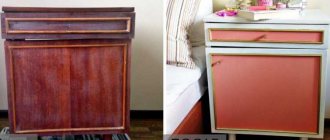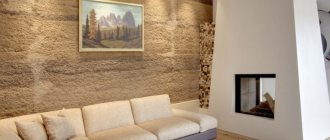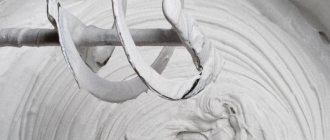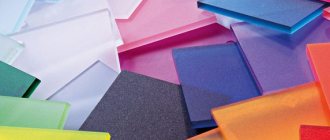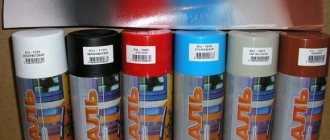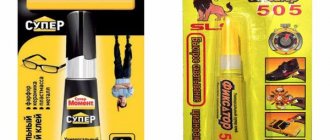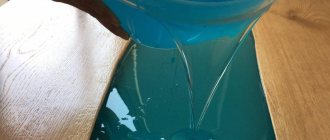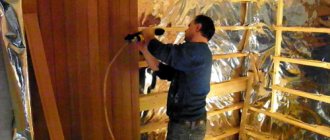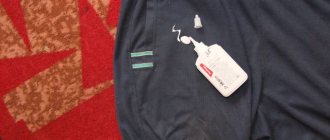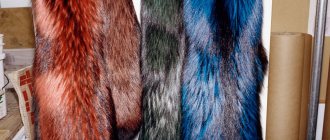Means for removing wallpaper from walls: composition features
On sale you can find a fairly large assortment of special products designed for removing wallpaper. Based on the type of base on which they are made, several groups of materials can be distinguished. The main properties of the compositions are presented in table form.
| Properties | Application area | |
| Products based on acids or solvents | They have a pungent odor and do not moisturize wallpaper well due to rapid evaporation. You should work with them only with special protective equipment. | Panels glued to bustilate, superglue, etc. |
| Alkali-based products | They easily penetrate into the material and effectively destroy adhesives of various compositions. Work requires protective equipment. | They help to effectively remove panels glued in several layers. |
| Compositions with nonionic surfactants | Biodegradable, completely safe. They destroy adhesives of organic origin well. | Canvas pasted in one layer. They are used in various concentrations for paper, non-woven fabric and vinyl. |
Most often, to facilitate the removal of wallpaper, a product with surfactants, also known as surfactants, will be sufficient. They are part of traditional detergents because they effectively dissolve fats and organic matter. To produce special glue-dissolving agents, a defoamer is used together with surfactants so that excess foam does not complicate the process of removing wallpaper panels.
Photo: silkinteriors.com.au
Advantages and disadvantages
The product significantly speeds up the process of preparing walls for gluing. Thanks to its safe composition and simple method of application, the popularity of the product is growing, as evidenced by positive reviews on construction forums.
Main advantages of the product:
• affordable price;
• harmless to human health, does not emit hazardous chemicals during use;
• economical consumption, allowing a small amount to process a large volume of working surface;
• environmental safety due to the ability to decompose in the natural environment and the absence of toxic substances in the composition;
• versatility;
• simple method of application, just dilute a certain portion of the composition with water;
• hypoallergenic;
• absence of unpleasant odor;
• fire safety.
Due to the absence of toxic components, the product has no disadvantages. However, it is worth considering that it can only be used for roll wallpaper. Liquid cannot remove liquid crystal finishing from walls.
Wallpaper remover: prepare at home
To obtain maximum effect, it is optimal to use industrial products. But in some cases you can prepare a similar composition yourself. Here are some recipes.
With laundry soap
Considering that laundry soap is a highly concentrated detergent, it dissolves organic adhesives very well. The easiest way is to simply wash a sponge with it, which is used to wet the wallpaper. But this is quite troublesome, so you can prepare a solution. The soap is grated, filled with water so that it is about 3-4 cm higher than the shavings. The solution is mixed and left for 10-12 hours or overnight. After complete dissolution, it can be used.
Photo: Instagram clever_mind69
With washing powder
Powder is poured into a container, you can take any, and filled with water in a ratio of 1:10. It is better that the liquid is hot, so the product will dissolve better. Mix the solution very carefully, without sudden movements. So that a minimum amount of foam is formed, which will interfere with working with the wallpaper. After dissolving, wait until the foam settles and use the composition.
With dish gel
The liquid is poured into water and completely dissolves in it. The ratio of ingredients depends on the actual density of the detergent. If it is a gel, then the proportion is 1 to 50; for liquid products, less water is taken. To quickly dissolve, the product is carefully mixed and left for a while so that the resulting foam settles. After which the composition is applied to the wall.
Photo: Instagram finnfox888
Preparing the room for wallpaper removal
To remove old wallpaper you need to prepare the following tools and materials:
- bucket or basin;
- spray bottle, wide brush (brush), long-haired roller with a long handle;
- set of spatulas;
- cuvette;
- step ladder
- polyethylene film;
- sponge and rags.
Preparatory work is carried out as follows:
- Before starting work, cover the floor with plastic film. It will protect the surface of the flooring from debris and splashes of water. Laminate parquet especially needs such protection when working with a spray gun.
- If possible, furniture should be removed from the room. The remaining furnishings are also covered with film.
- Disconnect all devices from the power supply.
- The housings of switches and sockets cover areas of wallpaper, so they are removed.
- It’s worth taking the time to buy a special paint cuvette. The tray has a recess with an inclined corrugated surface. During operation, the roller is dipped in water or in a solution for removing old wallpaper. Then, to prevent water from dripping onto the floor, the roller is wrung out on the corrugated part of the cuvette.
- You can moisten the paper coating with moisturizer. It is dipped into a bucket of liquid to remove wallpaper. Before moistening the walls, shake the brush slightly to remove excess moisture.
It makes sense to use a spray gun if there are large areas of surfaces to be treated.
Wallpaper removers
DIY wallpaper remover: pitfalls
Many people prefer to make their own wallpaper remover compositions. This is quite simple to do, and the costs are minimal. However, you need to understand that the effectiveness of homemade solutions is much lower than those made industrially. They will only be able to dissolve adhesives made on an organic basis and only when the concentration is chosen correctly. The composition of specialized products is selected to dissolve certain adhesives, so they act as efficiently and quickly as possible.
Photo: airtasker.com
How to use liquids
It is very easy to use the products, just read the instructions and dilute the liquids in certain proportions.
Step-by-step instruction:
- Dilute the solution as indicated on the package.
- Using a convenient tool, apply along the entire perimeter of the wallpaper.
- Wear goggles and gloves to protect your eyes and hands.
- Leave the liquid for some time to act.
- The wallpaper will either fall off under its own weight, or it can be easily peeled off using a spatula.
Wallpaper removers: methylane and others
Specialized compositions for wallpaper removal are presented in a fairly wide range. Each of them is designed to remove panels of a certain type, so the composition should be used only for its intended purpose. Such funds are considered the most popular.
Dissoucol by Quelyd
Designed to work with thin wallpaper and vinyl, and can remove whitewash. As in the previous case, to obtain a good result, you should strictly follow the manufacturer’s recommended proportions when preparing the solution. The product is completely safe and biodegradable. Easy to apply to the wall, does not flow. On average, one bottle is enough for 50-100 sq. m.
Methylane from Henkel
The German manufacturer produces a composition that will help remove any type of wallpaper: from heavy vinyl to light paper. The concentration of the product is important, so you need to prepare the solution exactly according to the instructions. Methylane is completely safe, does not contain aggressive solvents, and has no odor. It does not spread when applied, which ensures economical consumption. On average, one pack is enough for 200 sq. m.
Methylane from Henkel
Photo: Instagram oboistav
Tapex from Pufas
Composition for removing wallpaper of any type, can be used on the wall and ceiling. It does not spread when applied because it has a special consistency. The composition is absolutely safe and does not require subsequent removal from the base. Before use, it must be diluted with clean water. One package is enough for 75-100 sq. m.
Anti-wallpaper from Kleo
A potent alkali-based preparation. Sold as a concentrate, it can be dangerous if used carelessly. Quickly destroys various organic compounds, the solution is capable of removing wallpaper applied in two or more layers. When working, the use of protective equipment is required. One jar is enough for at least 75 square meters. m.
Anti-wallpaper from Cleo
Photo: Instagram k_metr
When choosing specialized drugs, you need to remember that they will be effective only when the manufacturer’s requirements are strictly met when diluting them.
Removing paper-based wallpaper
Paper wallpaper in the room
Over time, the paper covering can fade, peel, or simply tear. Ultimately, it just might get boring. If the paper trim is glued with a standard adhesive, then removing it from the walls will not cause any particular difficulties.
Glue for paper rolls is water-based. Therefore, in order to deprive the paper covering of the bonding layer with the base of the wall, it is enough to moisten the finishing surface with a water-soluble wallpaper remover.
If you try to remove dry paper with a knife, spatula or other sharp tool, then removing the coating can cause damage to the base of the fence. Then you will have to additionally putty and prime the wall.
The best wallpaper remover: how to choose?
Before you go to the store, you should accurately determine the type and condition of the wallpaper that is still on the wall. It is also important to know whether they are glued directly to the wall or to old wallpaper. It is advisable to know what glue was used for the job. Only by analyzing this information can you accurately determine the type of product you need to purchase. In addition, when choosing a composition, it is advisable to take into account the following points:
- Preparation time. It is good if the solution is ready for use immediately after dilution.
- Safety. Whenever possible, choose biodegradable formulations. They are odorless and absolutely safe.
- Consumption. Preference, of course, is given to the most economical means.
And one moment.
It is better to purchase the composition in a specialized store. The demand for solutions has led to the emergence of counterfeits, which can be purchased on the market much more often than in retail chains.
Photo: Instagram alex_snostorm
How to quickly remove old wallpaper in four ways
There are different methods for quickly removing old wallpaper from a wall. The choice of technology is determined by the state of the design and its type. So, what is guaranteed to remove paper webs may not work on vinyl ones. Therefore, before starting work, you need to determine the type of decor and check how firmly it adheres to the base. Based on this, choose the removal method. Let's look at each of them in detail.
"Dry" method
The method is good for materials of any type that are weakly held on the base. Most often this is single-layer paper.
Progress
- We stand on a stepladder and rise so that it is convenient to work under the ceiling.
- Use a sharp spatula to pry up the upper corner of the first strip. Carefully pull it down, trying not to tear it. We carefully separate the tightly glued fragments with a tool.
- Similarly, we remove the remaining stripes.
Fragments may remain firmly glued to the base. They are soaked and removed with a spatula. An important point: do not jerk the wallpaper sharply. It may come off faster, but the putty may partially collapse. Then you will have to additionally level the base. It is better to do everything carefully and gradually.
